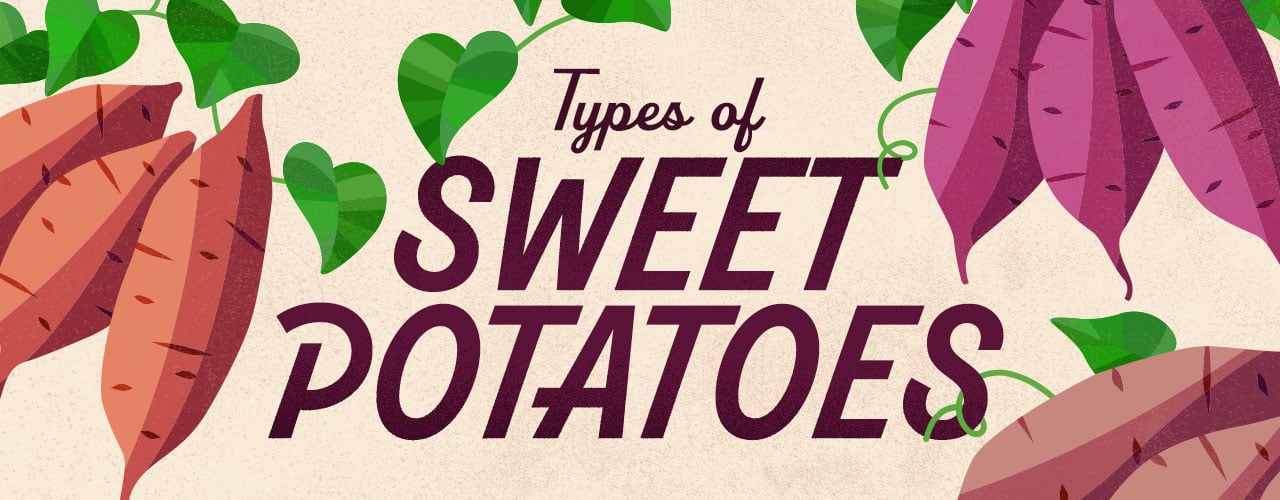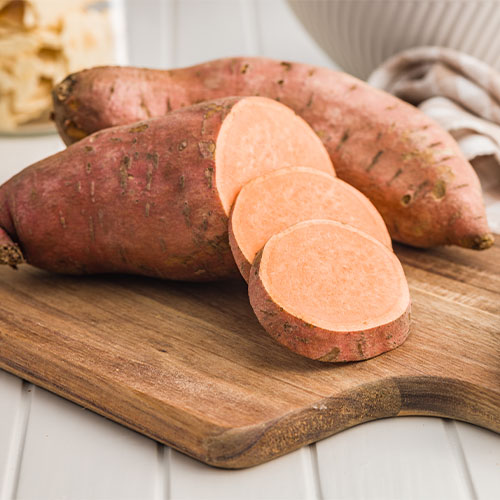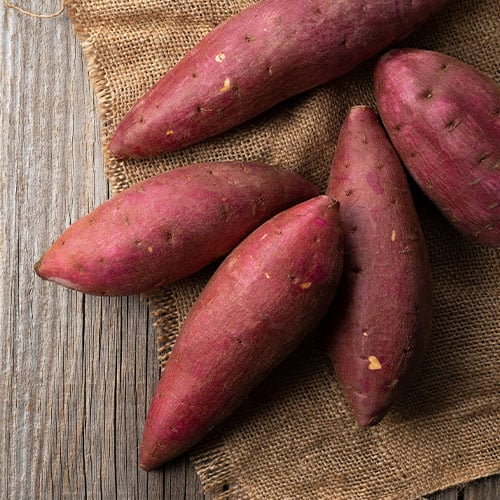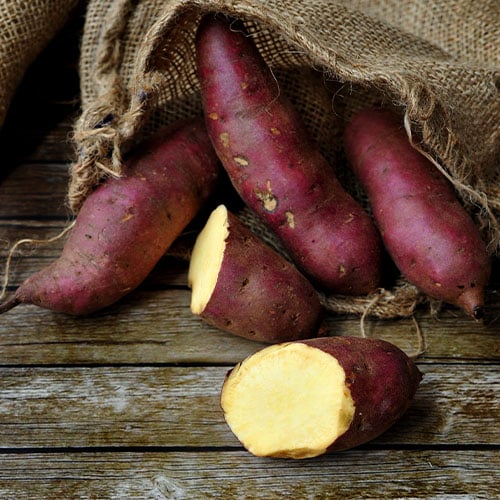
Available in an array of colors, such as vibrant orange and deep purple, sweet potatoes are a versatile and nutritious staple in many commercial kitchens. From sweet potato fries and chips to pies and casseroles, there are countless ways to incorporate these types of potatoes into your menu. We explore the different types of sweet potatoes and how they can elevate your dishes with their unique flavors and textures.
What Is a Sweet Potato?
Belonging to the Convolvulaceae family, sweet potatoes are tuberous root vegetables that come in a variety of colors, shapes, and sizes. They are known for their sweet flavor and are often used in both savory and sweet dishes. Sweet potatoes are rich in vitamins and minerals, making them a popular choice for health-conscious consumers.
Types of Sweet Potatoes
Create an eye-catching menu by adding a pop of color with sweet potatoes. There are several different types of sweet potatoes to choose from, each with its own unique characteristics and flavor profiles. We created a list of the most common sweet potatoes so you can find the best ones for your recipes.
1. Beauregard Sweet Potato

Beauregard sweet potatoes are one of the most popular types of sweet potato, known for their vibrant orange flesh and thin, copper-colored skin. They have a sweet and buttery flavor, making them a favorite ingredient in a wide range of dishes. One of the key features of Beauregard sweet potatoes is their high starch content, which makes them ideal for baking, roasting, and mashing. Their creamy texture when cooked also makes them a popular choice for soups, stews, and casseroles. Chefs and foodservice professionals appreciate Beauregard sweet potatoes for their consistent size and shape, which makes them easy to work with in a commercial kitchen.
- What Do Beauregard Sweet Potatoes Look Like? Copper, red-brown skin and bright orange flesh
- What Do Beauregard Sweet Potatoes Taste Like? Buttery, sweet, and slightly nutty
- Beauregard Sweet Potatoes Texture: Dense when raw, juicy and slightly fibrous when cooked
- How to Use Beauregard Sweet Potatoes: Considered “all-purpose” sweet potatoes, perfect for baking, mashing, or using for sweet potato gratin
2. Jewel Sweet Potato

Jewel sweet potatoes have a light orange to brown skin that conceals bright orange flesh. Their sweetness is slightly subdued, but the warm, earthy undertones make this sweet potato a fan favorite in commercial kitchens. Jewel sweet potatoes retain moisture well when baked or boiled, resulting in a creamy and fluffy final product, perfect for mashing and pureeing. Due to their vibrant color and sweet taste, Jewel sweet potatoes are often used in desserts such as pies, cakes, and muffins. They can also be incorporated into savory dishes, like soups, stews, and casseroles, to add depth of flavor.
- What Do Jewel Sweet Potatoes Look Like? Light orange-brown skin and orange flesh
- What Do Jewel Sweet Potatoes Taste Like? Mild sweetness, earthy, nutty undertones
- Jewel Sweet Potatoes Texture: Starchy, moist and fluffy when cooked
- How to Use Jewel Sweet Potatoes: Boiled, steamed, or mashed, perfect for casseroles
Beauregard vs Jewel Sweet Potato
Beauregard and Jewel sweet potatoes are similar in shape and color, but have distinct differences to look for. While both have bright orange flesh, Jewel sweet potatoes have light orange skin, while Beauregards have more of a copper tone. Beauregard sweet potatoes tend to have stringier fibrous flesh, whereas the Jewel sweet potato becomes fluffy when cooked. Beauregards are also sweeter than Jewel sweet potatoes.
3. Garnet Sweet Potato

Garnet sweet potatoes, also known as red sweet potatoes or red Garnets, get their name from their dark red-orange skin. Their deep orange flesh features a savory and slightly earthy flavor that is balanced with a hint of sweetness. Red Garnet sweet potatoes have a high moisture content, allowing them to become soft and tender when cooked. They are ideal for roasting, mashing, or blending into a puree. Because of their subtle sweetness, red Garnets are an excellent choice for pairing with marshmallows for a casserole as a Thanksgiving side.
- What Do Garnet Sweet Potatoes Look Like? Dark red-orange skin and deep orange flesh
- What Do Garnet Sweet Potatoes Taste Like? Savory earthiness, very subtle sweetness
- Garnet Sweet Potatoes Texture: Succulent, high moisture content that creates a velvety texture when cooked
- How to Use Garnet Sweet Potatoes: Excellent for roasting, blended for purees, or added as chunks in soups and stews
Garnet vs Jewel Sweet Potato
Garnet and Jewel sweet potatoes have clear distinctions, including their color, flavor, and texture. Jewel sweet potatoes are light orange, while Garnet sweet potatoes have deep red-orange skin. While both have orange flesh, Jewel sweet potatoes are sweeter than Garnet sweet potatoes, which have a more savory flavor. Both sweet potatoes have a high moisture content and become creamy and fluffy when cooked.
4. Hannah Sweet Potato

Hannah sweet potatoes, also known as white sweet potatoes, are a unique variety that stands out for their creamy white flesh and slightly sweet flavor. While they lack the bold color and tenderness of other sweet potatoes, Hannah sweet potatoes are a popular choice for commercial kitchens for making sweet potato fries. The Hannah sweet potato's firm texture allows it to hold its shape well when sliced into different fry shapes. The mild sweetness of fries made from Hannah sweet potatoes pairs perfectly with hamburgers. Because of their density, a sweet potato cutter can make the task of preparing sweet potato fries less strenuous in your kitchen.
- What Do Hannah Sweet Potatoes Look Like? Tan skin and white to light yellow flesh
- What Do Hannah Sweet Potatoes Taste Like? Slight sweetness, mild chestnut-like nuttiness
- Hannah Sweet Potatoes Texture: Firm and dense when raw, holds shape when cooked, slightly flaky
- How to Use Hannah Sweet Potatoes: Top choice for french fries, baked sweet potatoes, and cut into chunks
Garnet vs Hannah Sweet Potato
The difference between Garnet and Hannah sweet potatoes begins with their skin and flesh color. Hannah sweet potatoes have tan skin and pale flesh, while Garnet sweet potatoes have deep red skin and bright orange flesh. Hannah sweet potatoes are firmer and denser than Garnet sweet potatoes, making them a better option for sweet potato fries. Garnet sweet potatoes tend to be sweeter than Hannah sweet potatoes.
5. Okinawa Sweet Potato

Okinawa sweet potatoes, also known as purple sweet potatoes or Hawaiian sweet potatoes, are a unique variety with tan to light purple skin that conceals eye-catching purple flesh. Originally cultivated in the Okinawa region of Japan, Okinawa sweet potatoes are rich in antioxidants, particularly anthocyanins, which give them their purple hue. They have a sweet and almost floral flavor that many describe as being similar to roasted chestnuts. The natural coloring of Okinawa sweet potatoes makes them popular for desserts like tarts and cheesecake. While purple sweet potatoes look similar to ube (another Hawaiian staple), the two are distinctly different tubers, with ube tasting more like vanilla and coconut. Okinawa sweet potatoes have a dense and dry texture that can turn rich and creamy, like cake batter, when boiled or steamed.
- What Do Okinawa Sweet Potatoes Look Like? Tan to light purple skin and vibrant purple flesh
- What Do Okinawa Sweet Potatoes Taste Like? Mild sweetness with notes of florals and honey, flavor is reminiscent of roasted chestnut
- Okinawa Sweet Potatoes Texture: Dense, starchy, and dry when raw, crumbly when cooked, can become creamy when slow-cooked
- How to Use Okinawa Sweet Potatoes: Often steamed or boiled, used for Japanese and Hawaiian desserts like tarts and cheesecake
6. Japanese Sweet Potato

Japanese sweet potatoes, also known as Satsuma-imo sweet potato or Japanese white sweet potato, have deep reddish-purple skin and white to pale yellow flesh. They are slightly sweet, nutty, and buttery in flavor, making Japanese sweet potatoes a versatile ingredient in both sweet and savory dishes. While they can start off dry and crumbly, Satsuma-imo sweet potatoes absorb moisture well without becoming waterlogged, resulting in a velvety and fluffy texture when cooked. They can be baked, boiled, steamed, or roasted to create delicious dishes such as mashed sweet potatoes, fries, or pies. Add Japanese sweet potatoes to your hibachi or sushi menu by using them in stir-fries or frying slices in tempura batter.
- What Do Japanese Sweet Potatoes Look Like? Dark reddish-purple skin and white to light yellow flesh
- What Do Japanese Sweet Potatoes Taste Like? Rich, subtly sweet, nutty, and buttery
- Japanese White Potatoes Texture: Dry and starchy when raw, fluffy and smooth when baked
- How to Use Japanese Sweet Potatoes: Baked, roasted, or steamed, often sliced for tempura or stir-fries
Garnet vs Japanese Sweet Potato
Garnet and Japanese sweet potatoes both have dark red skin, but Garnets tend to be slightly more orange in color, while Japanese sweet potatoes have purple hues. When cut open, Garnet sweet potatoes reveal bold orange flesh, while Japanese sweet potatoes have white to pale yellow flesh. Japanese white sweet potatoes are sweeter than Garnet sweet potatoes, which boast a semi-savory taste. Japanese sweet potatoes are also drier than Garnets, making them a better choice for baked sweet potatoes. Reach for creamy Garnet sweet potatoes for mashed or pureed recipes.
Sweet Potato FAQs
These are some of the most common questions asked when it comes to sweet potatoes:The Difference Between Sweet Potatoes and Yams
Sweet potatoes and yams are often confused due to their similar appearance, but they are actually two distinct root vegetables. Sweet potatoes have a smoother skin and come in a variety of colors, including orange, white, and purple. Yams, on the other hand, have rough, dark brown skin and are starchier than sweet potatoes. Additionally, yams are typically larger in size and have a drier texture when cooked. While the term “yam” is often used for sweet potatoes in the U.S., true yams are typically only found in Africa and Asia.
How to Clean Sweet Potatoes
When preparing sweet potatoes for your commercial kitchen, proper cleaning is essential to ensure food safety and quality. Start by rinsing the sweet potatoes under cold running water to remove any dirt or debris. Use a vegetable brush to scrub the skin gently, paying attention to any crevices or eyes. For larger batches, consider using a commercial vegetable washer to streamline the process. Once clean, pat the sweet potatoes dry with a clean towel before proceeding with your desired cooking method.
How to Store Sweet Potatoes
Keep sweet potatoes in a cool, dark, and well-ventilated place, such as a pantry or cellar. Avoid storing them in the refrigerator, as the cold temperature can negatively affect their taste and texture. Additionally, make sure to remove any sprouts or soft spots before storing to prolong their shelf life. By following these simple storage tips, you can ensure that your sweet potatoes stay fresh and delicious for longer periods of time.
Can You Eat Sprouted Sweet Potatoes?
While sprouting sweet potatoes may not look appealing, they are still safe to consume. However, it's important to note that the texture and flavor of sprouted sweet potatoes may differ from fresh ones. Sprouted sweet potatoes can be used in recipes where the texture won't be a concern, such as in soups or stews. Just make sure to remove any green areas or sprouts before cooking to avoid any bitter taste.
Sweet potatoes are an eye-catching ingredient that can be an asset in any commercial kitchen. With different types, such as Beauregard, Garnet, and Jewel, offering unique flavors and textures, chefs and foodservice professionals have a range of options to choose from when incorporating sweet potatoes into their menus. Whether roasted, mashed, or baked, sweet potatoes can add a delicious and healthy twist to dishes across the culinary spectrum.





